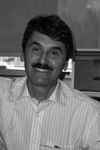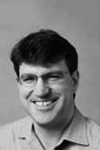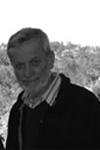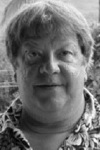principles of fluorescence techniques
april 7-10, 2020 | urbana-champaign, il
Dr. Beniamino Barbieri | ISS, Inc. | President | 1602 Newton Dr. | Champaign, IL 61822 | USA | Tel: 217-359-8681 | beniamino.barbieri@iss.com
Prof. Richard Day | Department of Cellular & Integrative Physiology | Indiana University School of Medicine | 635 Barnhill Drive, Room 333 | Indianapolis, IN 46202-5120 | USA | rnday@iupui.eduRichard Day is a Professor in the Department of Cellular and Integrative Physiology at the Indiana University School of Medicine. His research focuses on understanding the network of regulatory protein interactions that function to control cell-type specific gene expression. His laboratory group uses biochemical and molecular approaches to define networks of protein interactions that are coordinated by specific transcription factors. These in vitro approaches are then complemented by non-invasive live-cell imaging techniques using the many different color variants of the marine invertebrate fluorescent proteins. Recent studies from the laboratory have used Förster resonance energy transfer (FRET)-based microscopy approaches to begin to define networks of protein interactions in living cells.
Dr. Glenn Fried | Director of Core Facilities IGB | Room 15 | University of Illinois at Urbana-Champaign | 217-333-4328 | gfried@igb.illinois.edu
Prof. Enrico Gratton | University of California, Irvine | Department of Biomedical Engineering | Irvine, CA 92697-2715 | USA | Tel: 949-824-2674 | egratton22@yahoo.com
Enrico Gratton was born in Merate (Como) Italy. He received his doctorate degree in physics from the University of Rome in 1969. From 1969 to 1971 he was a post-doctoral fellow at the Istituto Superiore di Sanità in Italy. He went to the University of Illinois at Urbana-Champaign (UIUC) in 1976 and began his work as a research associate in the Department of Biochemistry. In 1978 he was appointed assistant professor in the Department of Physics at UIUC. In 1989 he was promoted to professor. Dr. Gratton's laboratory has reached international recognition for the development of instrumentation for time-resolved fluorescence spectroscopy using frequency domain methods.
In 1986 Dr. Gratton was awarded a grant from the National Institutes of Health, National Center for Research Resources, to establish the first national facility dedicated to fluorescence spectroscopy: the Laboratory for Fluorescence Dynamics (LFD). In 2006 the entire LFD laboratory moved to its current location at the new Natural Sciences II building at the University of California, Irvine. Dr. Gratton remains Principal Investigator of the LFD and holds joint appointments as Professor in the UCI departments of Biomedical Engineering and Physics and in the College of Medicine. The facility is a state-of-the-art fluorescence laboratory for use by local, national, and international scientists. It has a dual and equal commitment to research and development of fluorescence instrumentation and theory and to service in a user-oriented facility. Dr. Gratton's research interests are varied and many; they include design of new fluorescence instruments, protein dynamics, hydration of proteins, and I.R. spectroscopy of biological substances. Dr. Gratton has authored or co-authored over 400 publications in refereed scientific journals.
Prof. David M. Jameson | University of Hawaii at Manoa | Department of Cell and Molecular Biology | John A. Burns School of Medicine | Honolulu, HI 96822 | USA | Tel: 808-956-5034 | Website | djameson@hawaii.edu
A student of the late Prof. Gregorio Weber, David Jameson is Full Professor in the Department of Cell and Molecular Biology at the University of Hawaii. Prof. Jameson's research interests are focused on the development and application of time-resolved and steady-state fluorescence methodologies to elucidate dynamic aspects of biomolecules, including proteins, nucleic acids and membrane systems.
Currently, his laboratory is investigating several protein systems, including dynamin, a large (98kDa) GTPase which functions to "pinch-off" membrane vesicles in pathways such as receptor mediated endocytosis and synaptic vesicle recycling. This research involves both in vitro and in vivo studies on the self-association modes of dynamin as well as its interaction with membranes and other proteins such as endophilin and Arc. His lab also has a project on Botulinum Neurotoxin funded by Allergan, Inc. This project involves biophysical studies on proteins forming the neurotoxin complex as well as development of in vitro and in vivo toxin assays based on fluorescence fluctuation spectroscopy.
Author of more than 130 peer-reviewed articles, Prof. Jameson regularly reviews grants for the American Heart Association, the National Institutes of Health and the National Science Foundation. His research has been supported by grants from the National Institutes of Health, the National Science Foundation and the American Heart Association.
Prof. Paul Selvin | Professor of Physics & Biophysics | Affiliate of Cell & Developmental Biology | 365 Loomis Lab of Physics | 1110 W. Green St. | University of Illinois | Urbana IL 61801 | Tel: 217-244-3371 | selvin@illinois.edu
Paul Selvin earned a Ph.D. from the University of California, Berkeley, in 1990. Formally it was in physics, but in reality, it was in biophysics. The last experiment for his thesis, for example, was measuring the torsional rigidity of DNA by looking at a fluorophore intercalated in DNA, twisting around. A paper based on this experiment was published in Science (Selvin, 1992, Science) and later confirmed in a single molecule experiment (Bryant, Nature, 2003).
Professor Selvin did two sets of experiments during his postdoctoral training. One was developing a new type of fluorescence resonance energy transfer (FRET) based on lanthanides, called luminescence resonance energy transfer (LRET). He later used this technique to discover how a potassium ion channel, in part responsible for nerve conduction, responds to voltage (Cha, 1999, Nature; Posson, 2005, Nature). The second involved single molecule fluorescence—the first measurement of FRET between a single donor and single acceptor (Ha, 1996, PNAS).
After joining the Department of Physics at the University of Illinois in 1997, his interest has turned to molecular motors — proteins whose job is moving cargoes around the cell. For example, chromosomes are bound to molecular motors (kinesin and dynein) and under their power, are moved into the two halves of a cell during cell division. Selvin’s task was to determine how the motors moved. They were known to be dimeric, with two “feet,” held together by a head that consumed ATP (the universal food of the cell) and a stalk that bound to the cargo. It was also known that for each ATP burned up, these proteins moved between 8 and 37 nm, depending on the individual motor.
Selvin is now combing FIONA with optical traps (holding particles with light) in vivo, to see how many motors are causing such large velocities. Selvin’s future plans call for measurements in situ, for example, in Planaria and in C. Elegans, to test how these motors act in “real life.”







